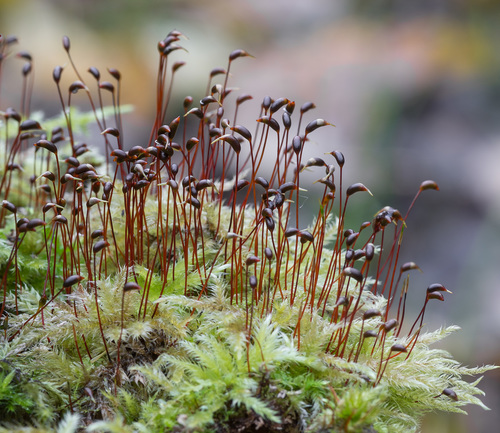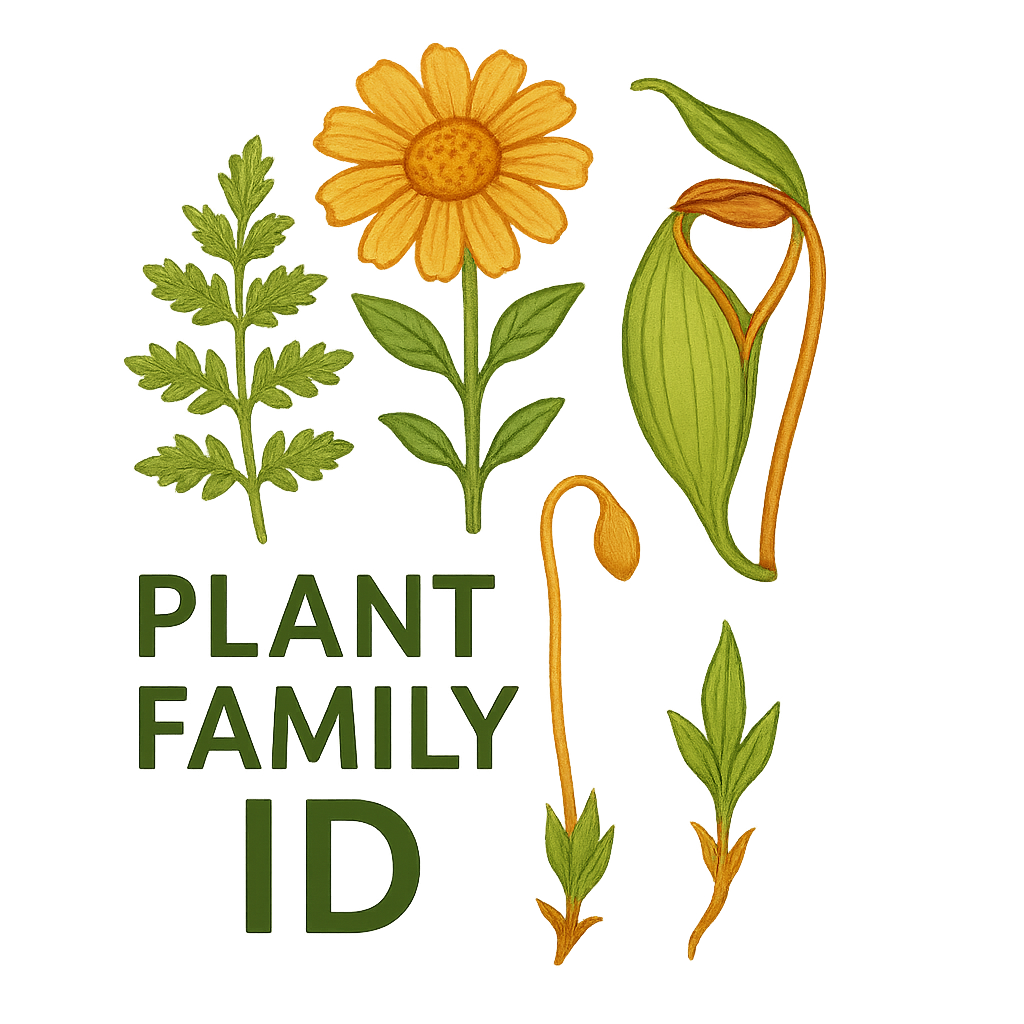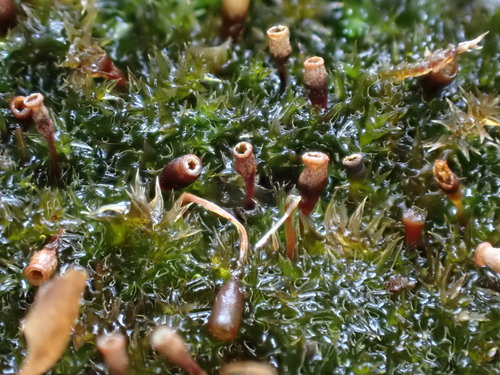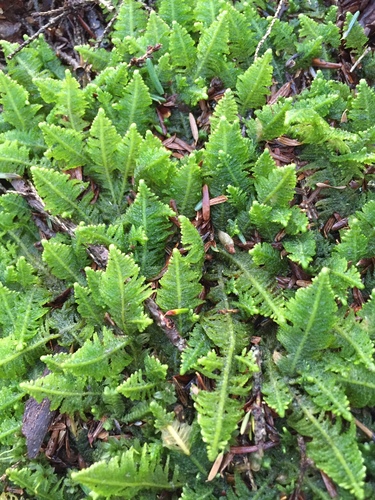Brachytheciaceae
Feather Moss Family / Brachythecium Moss Family
Brachytheciaceae is a large and ecologically diverse family of pleurocarpous mosses (mosses where sporophytes arise from short lateral branches). Members typically form loose to dense mats or wefts and are common worldwide in a vast array of habitats. Key features often include somewhat glossy appearance, ovate-lanceolate leaves that are frequently plicate (longitudinally folded), a single costa ending mid-leaf, and often a papillose (rough) seta supporting an inclined, ovoid capsule.

Overview
The Brachytheciaceae family is one of the most commonly encountered moss families globally, containing approximately 40 genera and around 600 species (though taxonomic boundaries are debated). Their success is reflected in their ability to colonize nearly every type of terrestrial habitat, from forests (on soil, logs, tree bases), grasslands, lawns, and disturbed ground to rocks, walls, stream banks, and even aquatic environments.
These mosses are typically pleurocarpous, spreading horizontally to form mats of varying density and texture. Many species have a characteristic sheen or gloss. While diverse, common traits include ovate-lanceolate leaves that often show distinct longitudinal folds (plicae), especially when dry, and a single midrib (costa) that usually fades out in the upper half of the leaf. The stalk (seta) supporting the capsule is notably rough or papillose in many common genera, a useful identification feature.
Ecologically, Brachytheciaceae play roles in soil stabilization, humus formation, and providing microhabitats. Some species are common weeds in lawns and gardens (e.g., Brachythecium rutabulum, Pseudoscleropodium purum), while others are characteristic components of woodland floor or streamside vegetation. Phylogenetically, they are a core family within the Hypnales, the largest order of mosses.
Quick Facts
- Scientific Name: Brachytheciaceae
- Common Name: Feather Moss Family, Brachythecium Moss Family
- Number of Genera: Approximately 40
- Number of Species: Approximately 600
- Distribution: Cosmopolitan, in nearly all terrestrial habitats.
- Evolutionary Group: Bryophytes - Mosses (Class: Bryopsida, Order: Hypnales)
Key Characteristics
Growth Form and Habit
Brachytheciaceae are pleurocarpous mosses, typically forming prostrate to ascending mats or wefts. Branching is usually irregular to subpinnate. Plants range from small and slender to large and robust, often with a somewhat glossy appearance when dry.
Stems
Stems are creeping or arching, with branches spreading or ascending. Paraphyllia (small filaments on the stem) are generally absent, but pseudoparaphyllia (small structures at branch bases) are often present.
Leaves
Stem and branch leaves may be similar or somewhat differentiated. They are typically ovate-lanceolate to triangular-lanceolate, usually acuminate (tapering to a sharp point). A key characteristic is that leaves are often distinctly plicate (with longitudinal folds or pleats), especially near the base, which can be obvious when dry. The costa (midrib) is single and usually moderately strong, typically ending mid-leaf or in the upper third, rarely reaching the apex. Leaf margins are frequently serrate or serrulate, particularly towards the apex. Leaf cells are typically elongate – linear, vermicular (worm-like), or rhomboidal – and smooth (not papillose). Alar cells at the basal corners are often differentiated, sometimes forming distinct groups of quadrate or inflated cells.
Asexual Reproduction
Specialized gemmae are rare in this family. Asexual reproduction primarily occurs via fragmentation or sometimes through deciduous branchlets or leaves in certain species.
Sporophytes (Reproductive Structures)
Sporophytes arise from short lateral buds. The capsule is elevated on a seta which is often (but not always) distinctly papillose (rough) due to projecting cell walls – this is a key feature for many common genera like Brachythecium and Eurhynchium. The capsule is typically short, ovoid to short-cylindric, usually inclined to horizontal, and often asymmetric or curved. It is generally smooth, not strongly ribbed like Aulacomniaceae or globose like Bartramiaceae. The peristome is double (diplolepidous) and well-developed, typical of the Hypnales order. The operculum (lid) is often conic to long-rostrate (long-beaked).
Habitat
Extremely variable. Found on a wide range of substrates including soil, humus, decaying logs, tree bases, rocks (acidic and calcareous), concrete, walls, lawns, grasslands, stream banks, and occasionally submerged in water.
Field Identification
Identifying Brachytheciaceae involves recognizing the pleurocarpous habit combined with leaf shape and features, seta texture, and capsule shape.
Primary Identification Features
- Growth Habit: Pleurocarpous, forming mats or wefts, often somewhat glossy.
- Leaves: Ovate-lanceolate, acuminate, often distinctly plicate (longitudinally folded, check base when dry). Costa single, ending mid-leaf or below apex.
- Seta Texture (Key Feature): Check the seta surface with a hand lens – it is often distinctly rough/papillose in many common species.
- Capsule Shape: Typically ovoid to short-cylindric, inclined to horizontal, not strongly ribbed or perfectly spherical.
- Habitat: Very broad range, common in many environments.
Secondary Identification Features
- Leaf Cells (Microscopic): Elongate (linear/rhomboidal), smooth.
- Alar Cells: Often differentiated at basal corners.
- Operculum: Often conic or with a long beak (rostrate).
Seasonal Identification Tips
- Year-round: The vegetative mats are present year-round. Plicate leaves are often easier to see when plants are dry.
- Sporophyte Timing: Sporophytes are common in many species, often maturing in winter, spring, or early summer depending on species and climate. The rough seta can be felt or seen with a lens on mature sporophytes.
Common Confusion Points
Brachytheciaceae can be confused with other pleurocarpous families:
- Amblystegiaceae: Often in wetter habitats, leaves usually not plicate, costa often stronger/longer, seta always smooth.
- Hypnaceae: Leaves often falcate (curved), costa usually short and double or absent, seta smooth.
- Plagiotheciaceae: Often flattened appearance, leaves asymmetric, costa short/double or absent, seta smooth.
- Entodontaceae: Typically very glossy, flattened mats, capsules erect and symmetric, different peristome.
- Thuidiaceae: Distinctly pinnate branching, stems covered in paraphyllia.
Look for the combination of pleurocarpous habit, often plicate leaves, single costa ending mid-leaf, often rough seta, and ovoid inclined capsule.
Field Guide Quick Reference
Look For:
- Pleurocarpous mats/wefts (often glossy)
- Leaves ovate-lanceolate, acuminate
- Leaves often plicate (folded)
- Costa single, ending mid-leaf/below apex
- Seta often rough/papillose
- Capsule ovoid/short-cylindric, inclined
Key Variations:
- Plant size and robustness
- Degree of glossiness
- Seta smooth or rough
- Operculum shape (conic to long-beaked)
- Habitat (extremely broad)
Notable Examples
This large family includes many common and widespread genera:

Brachythecium rutabulum
Rough-stalked Feather-moss
Extremely common and variable, found on soil, logs, tree bases, lawns, walls etc. Forms yellowish-green to green mats. Leaves ovate, acuminate, somewhat plicate. Seta distinctly rough. Capsule ovoid, inclined.

Homalothecium sericeum
Silky Wall Feather-moss
Common on base-rich rocks, walls, and tree bark. Forms dense, very glossy, golden-green mats pressed close to the substrate. Leaves triangular-lanceolate, strongly plicate. Seta rough. Capsule erect or slightly inclined, cylindric.

Pseudoscleropodium purum
Neat Feather-moss
Common in lawns, grasslands, and open woodlands. Forms pale green or yellowish, neat mats with characteristically tumid (sausage-like), pinnately branched shoots. Leaves broadly ovate, concave, shortly pointed. Capsules very rare in many regions. Seta smooth.

Rhynchostegium confertum
Clustered Feather-moss
A small, common species found on shaded rocks, walls, tree bases, and logs. Forms dense, dark green patches. Leaves ovate, pointed. Seta smooth. Capsule small, ovoid, inclined. Operculum with a distinct beak (rostrum).

Eurhynchium striatum
Common Striated Feather-moss
A large, robust moss common on soil and humus in woodlands. Forms loose, deep green mats. Branch leaves broadly triangular-ovate, strongly plicate ('striated' appearance). Seta rough. Capsule ovoid, inclined. Operculum long-beaked.
Phylogeny and Classification
Brachytheciaceae is a major family within the class Bryopsida and the large order Hypnales. The Hypnales encompass the majority of pleurocarpous moss diversity. Brachytheciaceae represents a core group within this order, characterized by its typical leaf shape, single costa, smooth cells, and often papillose seta.
The exact boundaries of the family and its relationship to other Hypnalean families like Amblystegiaceae are complex and have been subject to revision based on molecular data. Some genera traditionally placed here (like Eurhynchium) are sometimes treated in separate families or have complex relationships. Nonetheless, Brachytheciaceae remains a large, recognizable, and ecologically significant family within the pleurocarpous mosses.
Position in Plant Phylogeny
- Kingdom: Plantae
- Division: Bryophyta (Mosses)
- Class: Bryopsida
- Subclass: Bryidae
- Order: Hypnales
- Family: Brachytheciaceae
Evolutionary Significance
Brachytheciaceae exemplifies successful evolutionary radiation in pleurocarpous mosses:
- Ecological Versatility: The family's ability to thrive in an exceptionally wide range of habitats demonstrates high adaptability.
- Morphological Diversity: Shows considerable variation in size, branching, and leaf details within a common structural plan.
- Key Hypnalean Features: Exhibits characteristic traits of the Hypnales order, such as the diplolepidous peristome and typical pleurocarpous life strategy.
- Common Ancestors: Studying Brachytheciaceae helps understand the evolution and diversification of the vast Hypnales order.



